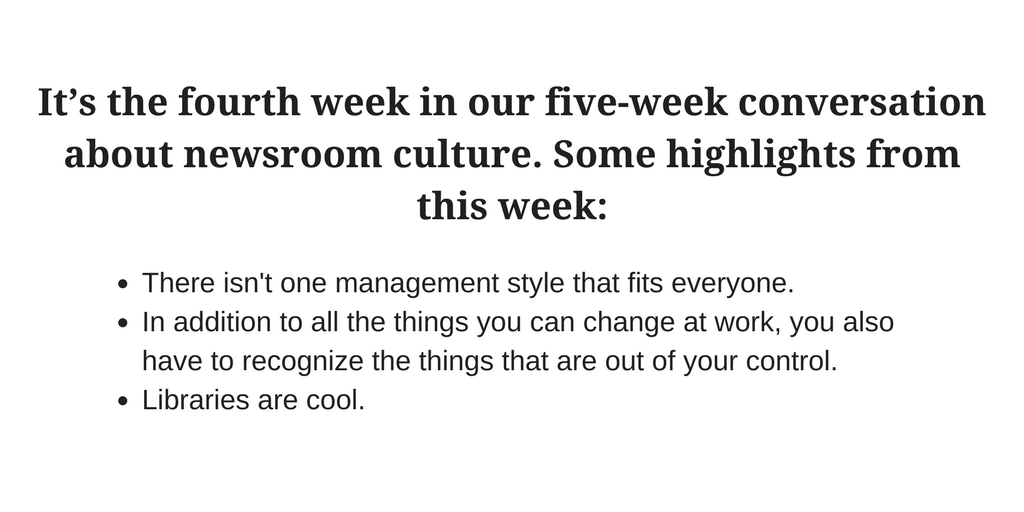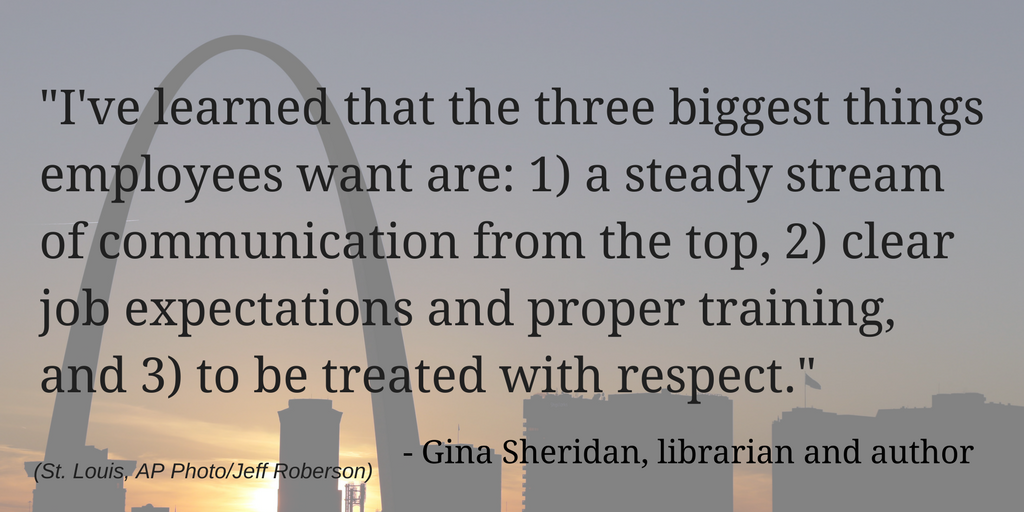This piece originally appeared in Local Edition, our newsletter following the digital transformation of local news. Want to be part of the conversation? You can sign up here.

Gina Sheridan’s Tumblr is a hilarious peek into life as a librarian.
She finds and collects stories from other librarians about odd notes written into the margins of returned books, the crazy things people request and, of course, kids.
Here’s one Gina shared last February:
Patron: “Do you have a book by someone named Márquez? I think it’s pretty famous and had a movie made about it: ‘Love in the Time of Chocolate?'”
Me: “I think you’re looking for ‘Love in the Time of Cholera.’”
Patron: “Are you sure? That sounds really depressing.”
Gina’s the manager of a branch of the St. Louis County Library and the author of “I Work at a Public Library: A Collection of Crazy Stories from the Stacks,” and “Check These Out: One Librarian’s Catalog of the 200 Coolest, Best, and Most Important Books You’ll Ever Read.” Her cats also have the best names: Surely Pancake and Buffalo Plush.
I’ve never met Gina in real life, but she’s one of my favorite people on the internet, and I thought she might have some thoughts about workplace culture.
She definitely does.
We chatted via email about creating great work culture, figuring out the things you can’t do anything about and what people really want from their workplaces.

Tell us about your workplace and your team.
I lead a team of 22 people from custodial staff to shelvers to professional librarians. I do my best to make sure each person knows they play an important role in the success of the library.
It’s important to me that staff come from a wide range of backgrounds and are representative of the community we serve. I spend time learning about each person’s talents and interests and try to give them tasks that I feel they would enjoy – because when you enjoy something, you naturally excel at it!
Because every person is different, there is no one-stop management style that works across the board. Each person is treated as an individual with a unique set of needs and skills.
One of the things I’ve learned by following your work is that everything I thought I knew about libraries was boring and wrong. I know that newsrooms, especially legacy newsrooms, often have similar cultures. Do libraries?
Just as the industry has changed over time, the perspective of culture has changed over time.
Today’s library is the most democratic institution in the community: a place where everyone belongs, regardless of who you are or what you want to accomplish. There is no expectation that you have to buy anything, check in with anyone, have an agenda, show ID.
Librarians aren’t hiding in an office behind closed doors with a receptionist as a buffer. We don’t give patrons 1-2 minutes of our time or charge them by the hour like so many other professionals.
We are here, we are open, we are welcoming. There aren’t many places like that anymore.
What are the biggest institutional issues you face with creating great work culture?
Within the bigger system, there seems to be a lack of recognition that internal customer service is as important as external customer service. We neighborhood branch employees rely on several services that are provided by our headquarters library and sometimes receive less than ideal customer service.
How do you deal with things like that?
By recognizing the limitations of my sphere of influence.
When I’ve experienced less than ideal internal customer service, it informs how I, in turn, manage my own branch staff. I think of my employees as customers. I’m here to serve them so they can do their best work. Also, when I mess up, I’m the first to admit it, apologize, and find a solution to move forward.
What can we non-librarians learn from you and your team about how to fix bad culture and cultivate good culture?
I’ve learned that the three biggest things employees want are: 1) a steady stream of communication from the top, 2) clear job expectations and proper training, and 3) to be treated with respect.
Every work environment and individual is unique, and you should treat them as such. I tell staff all the time that life is too short for an unhappy or negative work environment – that it takes all of us to work together and to learn from and trust each other. And that they should feel free to communicate their needs and suggestions because they are the front line staff and I trust their input.
Do you have any stories that illustrate the culture of your team?
The best story I can think of is actually quite sad.
Last year, one of my employees went on his lunch break and never came back to work. It turned out, he died suddenly while he was away. It was an incredibly difficult time for staff and for me.
Our co-worker was an excellent employee, and beloved by staff and library patrons alike. It occurred to several of us how strange it was that not only were we grieving his loss because he was such a fantastic person, but we were also feeling his absence in the amount of work he left. He was such a hard and conscientious worker, we hadn’t even realized how many things he handled without recognition.
I didn’t pretend to know how to handle the situation, but I did my best to communicate what info I could, and when I didn’t have any info, I checked in with people and offered support. I planned a memorial gathering for our friend and got those who wanted to help involved and gave those who grieved more quietly some space.
It’s hard to describe how we helped each other get through that and how close we became because of it. It’s an experience I will never forget.

Gina Sheridan, image courtesy Gina Sheridan.
Thank you, Gina!
Next week we’re going to wrap all this culture talk up with some final takeaways.
In the meantime, are you going to ONA? I’ll be there talking about lessons from local with the wonderful Sara K. Baranowski, editor of Iowa Falls, Iowa’s Times Citizen. Poynter columnist Melody Kramer tweeted some great reading recommendations on hiring and culture. And Poynter has a Webinar this Thursday on reporting on gender.
Thanks for reading! See you next week!







